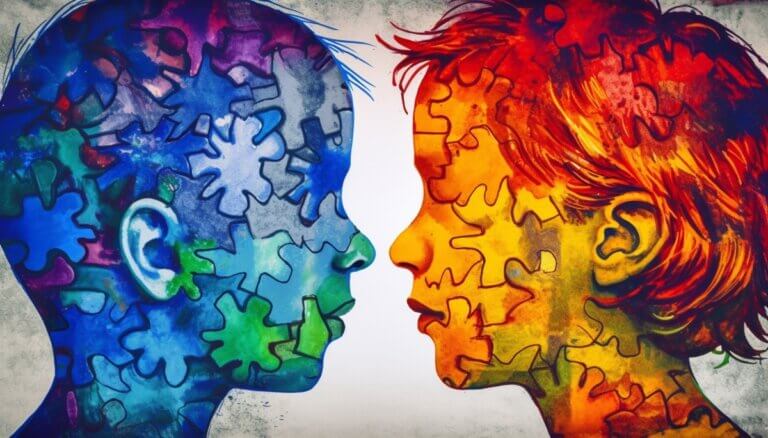Table of Contents
Emotional Intelligence as a Key Competence in Education

Recognizing and Understanding One’s Own Emotions
School time is not just a place for learning mathematics, languages, or science, but also a key field in which Emotional Intelligence should be fostered in the classroom. Successfully navigating the complex web of interpersonal relationships requires the ability to recognize and understand one’s own feelings. This competence is fundamental for personal development and is increasingly finding its fixed place in the curriculum.
Emotional Education Begins with Self-Awareness
Engaging with one’s own emotions forms the foundation of Emotional Intelligence in education. But how can this self-awareness be trained? Through regular reflection, for example in the form of diary entries, students learn to name their emotional states and analyze their causes. Thus, a simple event like a misunderstood comment in the hallway can lead a child to learn to distinguish disappointment from anger and react appropriately.
- In role-playing games, peers can enact different scenarios that encourage them to engage with their emotional reactions. Such practical exercises are especially valuable for experiencing and reflecting emotions in real contexts.
- Feedback loops with teachers, acting as mentors, provide additional support. Here, the student is guided in their process of gaining emotional insights and applying them in other areas of life.
- Visual aids like emotion cards or “mood barometers” in the classroom allow a non-verbal communication of feelings – an approach that can be particularly effective with younger children.
Practical Examples for Everyday School Life
The integration of Emotional Intelligence into the curriculum is evident in real-life applications. Consider Lena, who is excluded by her peers during group work. By being able to recognize her feelings of exclusion, Lena can respond appropriately, by seeking a conversation with those involved or obtaining support from a teacher.
Another example is Tim, who quickly becomes frustrated in physical education when things don’t succeed right away. Through regular reflection with the class on such moments, he learns to name his frustration and find ways to cope with it – such as through breathing exercises or a snapshot of positive progress.
In this way, the education sector of Emotional Intelligence contributes to the development of a robust self-concept and the enhancement of social skills. By supporting students in naming emotional experiences and learning different coping strategies, it lays the foundation for healthy personality development and ultimately for lifelong success.
Empathy and Social Skills in the Classroom
Empathy and social skills are essential pillars of Emotional Intelligence in Education. In a classroom that integrates not only knowledge but also Emotional Intelligence in the Curriculum, both academic and interpersonal successes are fostered.
Empathy as an Educational Goal
To prepare students for successful interactions in society, promoting empathy in the classroom is essential. Teachers play a key role in this by pursuing competence-oriented approaches. For example, role-playing where students put themselves in the shoes of different characters can make Emotional Education experiential. By empathizing with different perspectives, they develop understanding and care for others.
- Projects with a social focus, such as organizing a class party, foster cooperation and a sense of belonging.
- Peer mediation programs, where students mediate conflicts among themselves, enhance the ability to find emotionally intelligent solutions.
- Class discussions about current societal events sharpen the awareness of the emotional aspects of global issues.
Integration of Emotional Life Skills
The Education Sector of Emotional Intelligence involves more than just dealing with one’s own feelings. It aims to build a school culture that strengthens social skills and community spirit. A proven practice in this context is the ‘class council’, which offers a democratic forum to discuss class topics. Students learn to argue, listen, and make decisions together. This also fosters understanding of group dynamics and the role of each individual within them.
Empathetic Teaching Methods
How Emotional Intelligence in Teaching is implemented depends greatly on the educator. The targeted use of feedback methods that are not only performance-oriented but also take into account personal development is an effective approach. Positive feedback should always prevail to enhance motivation and self-efficacy. Equally important is the inclusion of all students in classroom discourse to avoid marginalizing anyone.
The development of emotional intelligence and social skills in education is an ongoing process that requires continuous reflection and adjustment. It affects not only social interactions but also academic success. In a world that increasingly demands networking and teamwork skills, this is an investment in the future of our society.
Integration of Emotional Intelligence into Curricula

Curriculum Design for Emotional Education
Emotional intelligence in education is increasingly becoming the focus of educators and curriculum planners. The establishment of emotional education within the curriculum is a step towards comprehensive personality development and provides students with important life skills. Designing a curriculum that promotes emotional intelligence requires a deep understanding of the principles and the impact of emotions on learning and behavior.
Integration of Emotional Education into Existing Subjects
Incorporating emotional intelligence in the curriculum does not necessarily require a separate subject. Instead, aspects of emotional development can be integrated into numerous existing subjects.
- In language courses, analyzing characters and their emotions can promote empathetic understanding.
- In social sciences, the effect of emotions on individual and group dynamics can be discussed.
- In art classes, students can learn to express emotions through various media, thus strengthening their self-perception.
Strategies for Curriculum Development
When developing curricula that foster emotional intelligence, it is essential to train educators accordingly. Educators must be able to convey emotional learning content and support the emotional development of their students.
- Teacher training and workshops provide an opportunity to impart fundamental competencies in emotional intelligence.
- Interdisciplinary project work can help apply emotional skills in a practical context.
- Regular reflection sessions, where students discuss their feelings and interactions, support self-awareness and social sensitivity.
International Perspectives as a Role Model
Looking beyond national borders, it is apparent that some educational systems have already successfully integrated methods to promote emotional intelligence into their curricula.
Scandinavian countries, known for their progressive educational concepts, focus on strong practical relevance and promote social and emotional competencies through cooperative learning forms. In Canada, methods are already applied in the earliest years of education that help children express their feelings and understand the emotional wellbeing of their peers.
Incorporating emotional intelligence into the curriculum is a process that not only focuses on the students but also includes teachers and the entire educational system. Through targeted training of teaching staff and conscious curriculum development, the groundwork can be laid for integrated emotional education, the benefits of which extend far beyond school years.
Assessment and Measurement of Emotional Intelligence
Emotional intelligence in the curriculum plays a central role when we think about the holistic development of our students. Not only academic, but also emotional development is crucial to provide children and adolescents with the best possible conditions for their life ahead. But how can emotional intelligence be measured and assessed in education? This is a challenge that occupies both educators and researchers.
Assessment Tools for Emotional Intelligence
To effectively develop and promote emotional intelligence in the classroom, appropriate tools are required that show teachers where a student stands. There are various approaches for this:
- Questionnaires and self-assessments provide insights into how students perceive their own emotional abilities.
- Observation forms allow teachers to analyze the interactions of students in the classroom to draw conclusions about their emotional competencies.
- Performance tests with situational questions can help evaluate emotional problem-solving ability.
Furthermore, projects and group work are a good assessment approach as they enable students to demonstrate their emotional competencies in social contexts.
Challenges and Solutions
A major issue in assessing emotional intelligence is its subjectivity. Emotional processes are individual and not as easily measurable as mathematical skills. In addition, students’ self-perception may differ from their actual competencies. For this, it is necessary to complement self-reports with objective observations and feedback from teachers and peers. Only then can a multidimensional and fair assessment occur.
Another challenge of emotional education lies in the diversity of students. Cultural and personal backgrounds play a significant role in the development of emotional intelligence. Educational institutions should develop adaptive programs that account for this diversity and provide each individual with the space for development.
The key to successful emotional intelligence in the curriculum lies in the continuous, integrative promotion of emotional skills and in close collaboration between teachers, parents, and the students themselves. The goal is to create a development environment through regular feedback and open dialogue, in which emotional intelligence can thrive, and thus optimally prepare students for the challenges of their future.
Summary
Emotional intelligence in education extends well beyond just learning academic content; it represents a central component in the development of students. Recognizing and understanding one’s own feelings – a key component of emotional intelligence – is fundamental for successful interpersonal interactions and is increasingly being incorporated into curricula.
The promotion of emotional education in schools begins with self-awareness. Journal writing helps young people to name emotions and explore their origins. Role-playing and discussions about emotions are effective methods to experience different perspectives and develop empathy within a safe framework.
Implementation in the Classroom
The practical application of emotional intelligence is evident in everyday situations. Students learn to navigate difficult social interactions and resolve conflicts through conversations and the support of teachers, which enhances their social competence. Visual aids such as emotion cards can particularly help younger children in supporting non-verbal communication of feelings.
The field of emotional intelligence in education emphasizes the role of empathy and views teachers as mentors who help students through competency-based approaches to put themselves in others’ shoes. This ability to take on different perspectives is crucial for successful social interaction.
- Socially focused projects promote cooperation and group belonging.
- Peer mediation strengthens the ability to constructively resolve conflicts.
- Discussions about current events help understand the emotional aspects of societal issues.
Incorporating emotional intelligence into the curriculum also means integrating emotional life skills across all subject areas. Processing emotions in artworks, addressing social behavior in social studies, or emotionally analyzing literary characters in language courses are ways emotional education can be promoted across disciplines.
Teachers play a key role in curriculum development and must be well-trained in teaching emotional competencies. International examples, such as the Scandinavian countries or Canada, serve as models for practical relevance and early promotion of emotional skills.
A challenge remains in measuring and evaluating emotional intelligence, as it is subjective and complex. Educators must rely on a combination of self-assessments, observations, and situational tests to obtain a comprehensive picture of students’ emotional competencies. The field of emotional intelligence takes on an essential role here and demands adapted pedagogy that meets the requirements of an ever-changing society.
FAQ – Emotional Intelligence in Education
How can the promotion of emotional intelligence be practically implemented in school education?
Promoting emotional intelligence in school education can be implemented through regular self-reflection exercises, communicative role-playing, and conflict resolution training, which teach students to recognize, understand, and appropriately respond to their own emotions. Embedding topics such as empathy and teamwork in the curriculum is equally important to help students understand perspectives of others and interact effectively in social groups. Teachers can act as role models and mentors by exemplifying emotional learning and creating a safe space for open exchange and constructive feedback.
How can emotional intelligence be concretely integrated into school curricula to improve the social skills of students?
Emotional intelligence can be integrated into school curricula by including courses or modules on topics such as self-awareness, empathy, conflict resolution, and communication skills. Through role-playing, cooperative group projects, and guided discussions, students can gain practical experience that helps them better understand and regulate their own emotions and those of their peers. Such activities create an environment where emotional and social competencies are developed alongside academic learning, thereby better equipping students for interpersonal challenges both in school and later in life.
How is emotional intelligence integrated and promoted in current curricula?
Emotional intelligence is integrated into modern curricula through targeted teaching units that promote self-awareness, empathy, and social skills. Teachers use interactive methods such as role-playing, group discussions, and reflection exercises to train students in the application and development of emotional competencies. For example, conflict resolution scenarios practiced in a classroom setting can provide practical insights on how emotional understanding can be positively utilized in everyday life.




